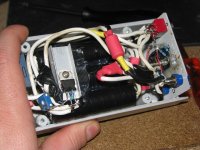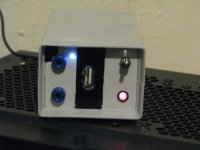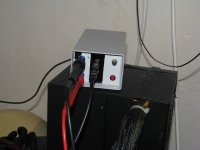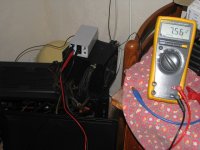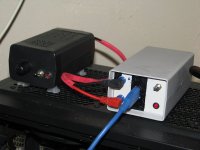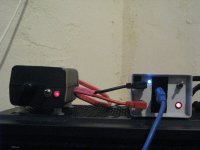But in general when you copy something it cannot be completely equal to the original. Some distortions must be introduced.
Not distortion, but quantisation noise. For undithered 16-bit digital, that is at -96 dB, but with shaped dither you can achieve 120 dB. Do you any analog recording media with 120 dB SNR?
Yes.Sorry .... are you saying that listeners have not been able to tell the difference between the direct signal and the same signal after a AD and DA conversion?
There have been many such tests, using different equipment, and mostly it doesn't matter what converters were used.If you tell me which AD/DA converter they have used for the test i would be very interested.
There was the famous one, documented here where Ivor Tiefenbrun, the founder of Linn, couldn't tell when a 16-bit digital path (Sony PCM-F1) was inserted in an analog chain containing a LP-12 turntable, Naim amps and Linn speakers.
It was - the background noise was audible to the people running the test, as the digital chain was effectively running in 13-bit mode, but Tiefenbrun didn't notice it.I am afraid with a very good playback system the difference between direct feed and the same feed after passing a AD and DA process should be maybe minimal but evident.
Probably yes, most of us grew up with it, assuming that is how it was supposed to sound. I know I prefer the sound of some tube amps with rather high distortion - but I realize it is my personal preference rather than the natural sound.it could be that i am used to this kind of familiar distortion?
In the research reports I have seen (AES has some interesting ones), what is often perceived as "soundstage" is a slight unevenness in frequency response.sorry but also for soundstage reproduction ? this is very difficult for digital IMHE ... a very challenging test indeed
Only the best digital sources have a nice 3D effect ... and they are usually very expensive. Very very.
And how precise is the speed of a vinyl player or tape deck?I agree for the best digital source but not for the average that use low quality quartz and noise power supplies to power the clock circuit.
How much clock variation do you think is needed to actually be audible?
I doubt you could tell a decent $600 DAC from a good $50 DAC in a controlled, double-blind listening.A good dac usually starts from 5-600 USD and it is only part of the story.
Only if your DAC derives the audio clock from the incoming data clock. More modern designs completely isolate the aucio clock from the data clock.The transport and even the connection can impair the overall result
Not distortion, but quantisation noise. For undithered 16-bit digital, that is at -96 dB, but with shaped dither you can achieve 120 dB. Do you any analog recording media with 120 dB SNR?
Hi again 🙂 problem is if this quantisation noise can be audible ...
Yes. There have been many such tests, using different equipment, and mostly it doesn't matter what converters were used.
There was the famous one, documented here where Ivor Tiefenbrun, the founder of Linn, couldn't tell when a 16-bit digital path (Sony PCM-F1) was inserted in an analog chain containing a LP-12 turntable, Naim amps and Linn speakers.
Thank you very much indeed for the very interesting link.
It was - the background noise was audible to the people running the test, as the digital chain was effectively running in 13-bit mode, but Tiefenbrun didn't notice it.
ok background noise if you mean ambient noise is not part of the music signal.
They should have selected a better place to run the test of course.
Still i cannot believe that direct feed and AD/DA processed feed sounds exactly the same ... this is for me an enourmous achievement for a AD/DA processor ... complete transparency ... unbelievable and amazing indeed.
But if you say so ... still ... 😀
This for me would be the ultimate test for an audio interface or a standalone digital recorder ... amazing performance.
Probably yes, most of us grew up with it, assuming that is how it was supposed to sound. I know I prefer the sound of some tube amps with rather high distortion - but I realize it is my personal preference rather than the natural sound.
ok and you are not alone in liking some tube amps ... also myself i have been extremely pleased by listening to some tubes.
In the research reports I have seen (AES has some interesting ones), what is often perceived as "soundstage" is a slight unevenness in frequency response.
Maybe i have been a little confusing ... there are some cd tests which tracks useful to test the ability of a playback chain in this regard.
These tracks can also be the result of some DSP ... but still give the feeling of a virtual 3D stage.
Some systems are better than other especially in the depth direction.
Some people instead state that it is just a matter of room acoustic.
A decent system in a well treated room can give a very good 3D effect 🙄
And how precise is the speed of a vinyl player or tape deck?
How much clock variation do you think is needed to actually be audible?
ok ... this is quite clear. No more doubts about this.
I doubt you could tell a decent $600 DAC from a good $50 DAC in a controlled, double-blind listening.
Only if your DAC derives the audio clock from the incoming data clock.
More modern designs completely isolate the aucio clock from the data clock.
This is very interesting. Do you think that a DAC relying only on the incoming data clock for the audio clock can sound very good indeed anyway ?
or some sort of reclocking inside the dac is needed for a very good sound ?
This is a very important point i think.
I have seen in the past even units to be put between the source and the dac to perform a sort of reclocking. They say they are beneficial.
Thanks a lot again, gino
 Guys, there's about umpty-million threads in the Lounge on audiophile chit-chat. If you want to go off the topic of modifying USB cables for power and talk about digital vs. analog, or tubes vs. solid state, or more filling versus tastes great, or whatever, feel free to use one of those threads to do it. Stick to the topic here.
Guys, there's about umpty-million threads in the Lounge on audiophile chit-chat. If you want to go off the topic of modifying USB cables for power and talk about digital vs. analog, or tubes vs. solid state, or more filling versus tastes great, or whatever, feel free to use one of those threads to do it. Stick to the topic here.My DAC sounds fantastic through its SPDIF input but when driven through USB the sound quality strongly depends on the associated computer.
I know it should not happen with async USB but the difference is clearly audible.
With my laptop (battery powered) it sounds great, with one of my Mac Minis it sounds acceptable and with my newer Mac Mini with integrated SMPS it sounds awful.
Seeing as you enjoy the sound with a battery powered computer as source, the problem seems to be common-mode noise generated by the SMPSU in your Mac Mini. Do you know if its possible to obtain a linear supply for the Mac Mini? It would likely cure your SQ problem. If not then a common-mode choke on its mains supply and ferrite clamps around the USB cable may well help, but probably not completely fix, the problem.
Indeed. I remember breaking into a USB cable to use outboard power to DAC. It was back in '08, so I don't remember what was needed to signal the computer to activate the USB port. Might have been the resistor mentioned early in the the thread. Whatever it was, it worked. Wish I could remember what I did to signal the computer. Just remember that "something" was needed.
You might also think about building a "Line Lump" filter to fit into the USB path. Something like a CLC filter on the power line to clean it up. It might be enough to get you clean power out of the USB port.
You might also think about building a "Line Lump" filter to fit into the USB path. Something like a CLC filter on the power line to clean it up. It might be enough to get you clean power out of the USB port.
i must say this thread got me thinking ,and then i built battery powered usb cable/box with switch between battery and normal usb power, i hear no difference in sound as could be suggested by lot of people on this thread,but maybe i did something wrong.
Attachments
Indeed. I remember breaking into a USB cable to use outboard power to DAC. It was back in '08, so I don't remember what was needed to signal the computer to activate the USB port. Might have been the resistor mentioned early in the the thread. Whatever it was, it worked. Wish I could remember what I did to signal the computer. Just remember that "something" was needed.
You might also think about building a "Line Lump" filter to fit into the USB path. Something like a CLC filter on the power line to clean it up. It might be enough to get you clean power out of the USB port.
simple led and resistor worked ,but it wont work as usb phone charger (DIY Universal USB Charging Adapter (Step-By-… | Samsung Galaxy Tab 10.1, 10.1v | XDA Forums)
but if you have problems just turn off
/allow windows to turn off this device to save power/
in device manager
not sure is it placebo but now i added charger for my box and it seems that sound is little better now.
any thoughts on how to test this setup vs normal usb power, another sound card on laptop then record loopback with some program or how??
Attachments
- Status
- Not open for further replies.
- Home
- Source & Line
- Digital Line Level
- Modding USB cable to power DAC with external PSU
